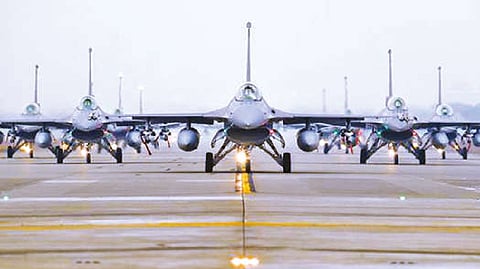

Srinivas Mazumdaru
Tensions between China and Taiwan have been rising in recent years driven by differences over the island’s status. Beijing claims sovereignty over the territory and has pledged to “unify” it with the mainland — by force if necessary. Any military clash over Taiwan could also drag in the United States, given Washington’s special ties to Taipei. How did it start? China and Taiwan have been separated since 1949, when the Chinese civil war ended with the victory of the Communists under the leadership of Mao Zedong. The defeated Nationalists, led by Mao’s archrival and chief of the Kuomintang (KMT) party Chiang Kai-shek, retreated to Taiwan. Taiwan, which has been governed independently since then, is officially known as the Republic of China while the mainland is called the People’s Republic of China.
The island is separated from the mainland by the Taiwan Strait. It has a democratically elected government and is home to around 23 million people. For over seven decades, Beijing has continued to view Taiwan as a renegade province and vows to “unify” it with the Chinese mainland. Beijing’s stance is that there is only “one China” and that Taiwan is part of it. China pressures countries worldwide to switch their allegiance to Beijing and cut diplomatic ties with Taiwan. At present, only 14 countries maintain official diplomatic relations with Taiwan. Taipei is also not a member in agencies of the United Nations, although it holds membership of organizations like the Asian Development Bank and the World Trade Organization.
China also puts pressure on companies worldwide to list Taiwan as a part of China. Governments and firms that do not toe Beijing’s line on the issue risk backlash from the Chinese government. In 2021, for instance, China cut off trade with EU member Lithuania for opening a Taiwanese representative office in its capital. For almost three decades after the Communist government came to power in mainland China, the United States recognized Taipei as the government of all China. But in 1979, Washington revoked its diplomatic ties and its mutual defense treaty with Taiwan and established formal diplomatic relations with mainland China.
Despite the shift, Washington has maintained close unofficial ties with Taipei. It continues to sell military gear to Taiwan for self-defense, even though Beijing has repeatedly warned the US not to do so. US Navy warships also regularly sail through the Taiwan Strait to project American military power in the region.
The US says its goal is to ensure peace and stability in the Taiwan Strait. To this end, it wants to maintain the status quo.
Under President Donald Trump, the US deepened military ties with Taiwan and increased arms deliveries, selling over $18 billion worth of weapons to the island. President Joe Biden has said the US would come to Taiwan’s defense if China attacked.
Beijing hasn’t ruled out using force to pursue reunification of Taiwan with China. In a major speech in January 2019, Chinese President Xi Jinping called for reunification and said that the status quo could not continue forever. “We make no promise to renounce the use of force and reserve the option of taking all necessary means,” he said at the time. Xi has also stressed that the reunification is essential for the realisation of the “Chinese dream” of restoring the country’s great-power status in the world by 2049.
China is increasingly sending its fighters, bombers and surveillance aircraft near Taiwan, while also dispatching warships through the Taiwan Strait in a show of force.
The willingness to use force, coupled with China’s rapidly expanding military capabilities and deteriorating cross-strait relations, has raised fears that it could trigger a conflict.
Visit news.dtnext.in to explore our interactive epaper!
Download the DT Next app for more exciting features!
Click here for iOS
Click here for Android